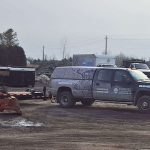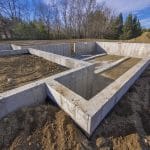Trees can indirectly contribute to foundation damage, but others factors often play a larger role
You’re sitting on your front porch enjoying a refreshing iced tea. Leaves rustle from your beautiful maple tree. Its shade provides relief from a blazing hot afternoon sun.
Your neighbour stops by and says, “That big old tree’s roots are gonna damage your foundation. You might wanna cut it down before it’s too late.”
Should you be worried? The answer depends.
Trees aren’t a direct cause of foundation damage. They can, under specific conditions, indirectly contribute to it.
Water, soil, and your foundation
Trees are living organisms which require water to survive. Their roots extract water from the soil.
Certain types of soil, like clay, shrink a lot when they dry, as in prolonged droughts.
Tree roots themselves don’t actually damage a foundation. It’s the contraction from drought which can pull away supporting soil from around or beneath a foundation. This leaves room for the foundation to settle unevenly, which can cause cracks.
A large tree that’s close to a house can add to the problem by drawing additional moisture from the soil.
But trees aren’t the only culprit.
Improper backfill can lead to problems
When builders create a house foundation, a big hole has to be dug. Depressions and hollow spots are left in the excavated area. These spots need to be backfilled with soil that’s lighter than the native virgin soil.
After a foundation has been poured, soil must also be backfilled against the foundation’s walls.
In order to compensate, builders compact the fill soil to approximate the surrounding soil. Improperly compacted backfill can result in soil settlement and allow water to drain toward the foundation.
If backfill is heavy in clay, there is more potential for shrinkage during drought.
After long droughts, significant soil shrinkage around and under the house can leave an avenue for water from heavy rains to find its way into cracks that may have developed from uneven foundation settling.
Clay soils also expand a great deal when wet. After sustained periods of rainfall, or after a heavy snowmelt, a lot of pressure can be placed against foundation walls, resulting in cracks, which can allow water to enter.
A number of homes in the Ottawa area experienced foundation problems after months of drought in 2012 were followed by a lot of rain.
Large trees near a house are often blamed for foundation damage, but a host of other factors can play a larger role.
Depth of foundation
Houses with shallow foundations are more prone to damage from drought, as the soil closer to the surface dries quicker than deeper soil. Tree roots can potentially grow under the house and more easily draw moisture. This can lead to settling and foundation cracks.
Tree roots do not easily grow to the base of a full basement foundation, and generally, don’t penetrate sound footings.
Roots have to grow near the base of a foundation to contribute to any significant damage caused by drought.
Repeated cycles of drought, followed by heavy rain, have more potential to affect homes with shallower foundations.
Grading, drainage, landscaping around the house
The ground around the perimeter of a house should slope away to prevent water from pooling around the foundation. Downspouts should discharge far enough to allow water to drain away from the house.
Improper garden design around a foundation can also block water from draining away and can contribute to pooling.
A leaky plumbing drain can leach water into the soil, giving tree roots a source of moisture. Roots can enter and block old drains with rigid joints or poor seals. Watertight drains don’t pose a problem.
Keep an even moisture content
While it’s important that water drains away from your foundation, it’s equally important to maintain a consistent soil moisture to combat soil shrinkage.
Shrubs and smaller plants planted around the house can help. Their roots keep the soil in place and prevent erosion.
A layer of mulch can retain moisture and help slow evaporation. It also allows rainfall to enter the soil more evenly. Avoid placing thick layers of mulch directly against the foundation, as this may attract pests such as termites.
During droughts, if you see a gap between the soil and your foundation, the soil needs moisture. You can use a drip hose to slowly add moisture. A drip hose attaches to a faucet and has small holes to allow water to drip at a slow, steady rate. Lay the hose around the perimeter of the foundation. Once the gap closes, you can reduce the amount and frequency of watering.
Cutting down a tree is the last resort
You may have some mature trees on your property, often planted by previous homeowners.
Before you consider removing a tree, you should confirm tree roots are actually present at the base of the foundation.
If the backfill around a foundation hasn’t been compacted properly, tree roots may grow down when they meet the looser soil. You might be able to find these roots by digging within a few feet of your foundation. They are often found a couple feet down. If you find any roots, cut them off.
In less common cases, you may need to excavate to the base of the foundation to remove the roots.
A root barrier can be installed to prevent re-growth, although this can be expensive.
Cutting a tree down is always a last resort. In Ottawa, on properties less than one hectare, a permit is needed to remove any tree with a diameter of 20 or more inches.
For properties bigger than one hectare, a city-approved Tree Conservation Report is needed to remove any tree with a diameter of 4 or more inches.
Consider these things when planting a tree
Trees are often unfairly blamed for foundation damage. They provide many benefits, such as natural beauty, shade, and filtering pollutants. So go ahead, plant a tree!
To protect your foundation, keep these things in mind:
- Plant slow-growing trees that have less aggressive roots, such as oak or sugar maple
- Avoid willow, honey locust, silver maple or elm, unless you have a large yard
- Tree roots can grow twice, even three times as wide as tree height
- Know the full size a tree will grow to
- Plant trees far enough away from the house—at least 20 feet (but it really depends on the size and species of the tree)
When should you consult a foundation repair specialist?
Trees don’t pose as much of a problem to foundations as many people say. During droughts, they often get blamed when other factors such as clay soils, poorly compacted backfill, or pre-existing foundation cracks often play a larger role.
If you’ve noticed cracks in your foundation, or are worried about the backfill surrounding your home, you may wish to consult a foundation repair specialist.
In the meantime, the next time your neighbour tells you to cut down your beautiful tree, you’ll be a bit more informed. And you can enjoy your iced tea.








